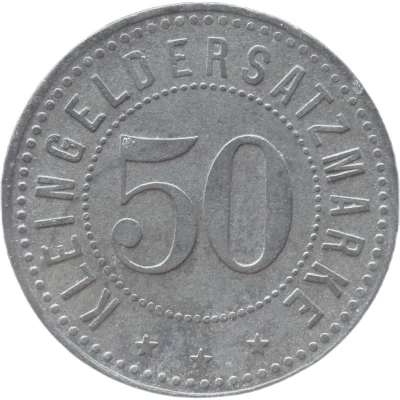


© Willem63 (CC BY-NC-SA)
50 Pfennigs - Züllichau
1918 year| Zinc | 3.9 g | 25.4 mm |
| Issuer | City of Züllichau (Prussian province of Brandenburg) |
|---|---|
| Issuing entity | Sparkasse der Stadt Züllichau |
| Type | Standard circulation coin |
| Year | 1918 |
| Value | 50 Pfennigs (50 Pfennige) (0.50) |
| Currency | Mark (1914-1924) |
| Composition | Zinc |
| Weight | 3.9 g |
| Diameter | 25.4 mm |
| Thickness | 1.4 mm |
| Shape | Round |
| Technique | Milled |
| Orientation | Medal alignment ↑↑ |
| Demonetized | Yes |
| Updated | 2024-10-04 |
| Numista | N#345685 |
|---|---|
| Rarity index | 92% |
Reverse
Pearl rim, legend surrounding pearl circle, denomination centered
Script: Latin
Lettering:
KLEINGELDERSATZMARKE
50
★★★
Edge
Plain
Interesting fact
The 50 Pfennigs - Züllichau 1918 coin was minted during a time of economic turmoil in Germany, known as the "Inflationary Period" (1914-1923). During this time, the value of the German mark (the national currency) plummeted, and prices for everyday goods skyrocketed. As a result, many Germans turned to alternative forms of currency, such as local emergency currencies like the 50 Pfennigs - Züllichau 1918 coin, which was issued by the City of Züllichau in 1918. This coin, made of zinc and weighing 3.9 grams, was used as a substitute for the official German currency, and it remained in circulation until the introduction of the Rentenmark in 1923, which helped to stabilize the German economy.